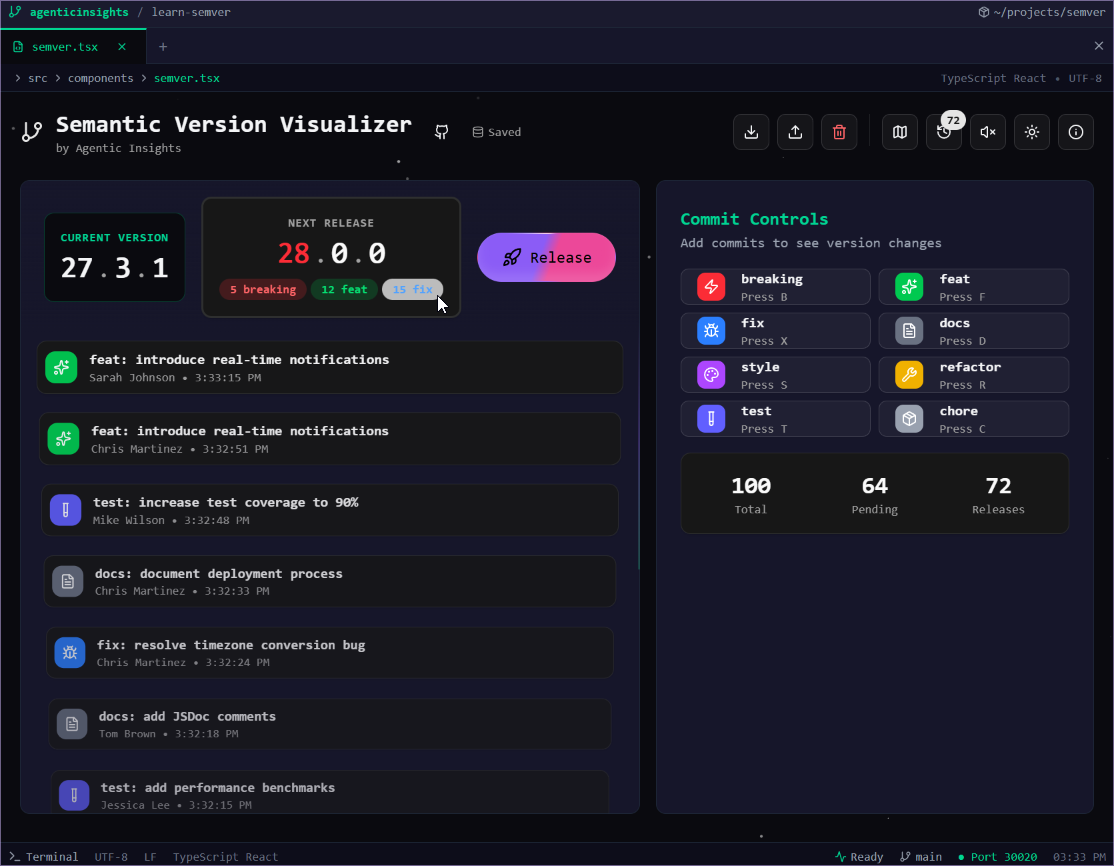A Two-Hour Prototyping Session
Building Learn-Semver with Claude Code
Two hours. That's all it took to go from concept to functional interactive tool using Claude Code and modern agentic development practices. The result? A simple semantic versioning visualizer that demonstrates rapid prototyping techniques while serving as a practical educational tool. (GitHub Repo)
This small project showcases a prototyping method that development teams can adopt immediately. While learn-semver itself is just a toy example, the same rapid prototyping approach applies to larger projects and more complex AI-assisted development workflows.
The Power of Rapid Prototyping with AI
The entire learn-semver application was built in under two hours using Claude Code, demonstrating a practical prototyping method where AI agents handle implementation details while developers focus on vision and user experience. Built with Next.js, ShadCN, and MagicUI, it follows the design patterns we're exploring at Agentic Insights – clean, interactive, and compelling.
This speed of development shows what's possible with current tools. When you can prototype and iterate this quickly, it becomes practical to:
Validate concepts before major investment
Create educational tools on-demand
Explore interface ideas rapidly
A Simple Tool with Two Uses
Primary Use: Teaching Semantic Versioning
For development teams new to semantic versioning, learn-semver offers a quick, visual way to understand the concept:
Interactive commit categorization: Drag and drop commits to understand how different types (breaking, feat, fix, chore, etc.) affect version numbers
Real-time version calculation: See instantly how your commit strategy translates to version bumps
Release simulation: A simple button shows what happens when you trigger a release, making the abstract concrete
Historical changelog view: Explore how versions evolve over time with a clean, navigable interface
Practical Uses:
Teams can understand version number impacts visually
Developers can experiment with versioning strategies safely
Tech leads have a quick demo tool for explaining semantic versioning
Secondary Use: Exploring Interface Concepts
While primarily an educational tool, learn-semver also serves as a simple exploration of interface concepts. As we work toward systems where multiple AI agents collaborate on code (like the upcoming orchestr8 project), we'll need intuitive ways to visualize these processes.
The learn-semver visualizer explores these ideas in miniature:
Commit categorization as task assignment: Each commit type could represent a different agent's contribution
Version progression as coordination: Multiple agents' work combining into coherent releases
The changelog as activity log: Tracking what was accomplished and when activity log**: Tracking what each agent accomplished and when
This dual nature – educational tool today, interface exploration tomorrow – makes it a useful prototype for teams interested in AI-enhanced development workflows.
Technical Implementation
see the GitHub Repo
Everything runs locally in the browser using localStorage for persistence. No backend, no authentication required. This makes it immediately accessible for teams to try without any setup or approval processes.
The interface includes links to related concepts throughout, and the changelog view provides a historical perspective on version progression.
Deployment and configuration was included, I already had the Cloudflare domains setup, and Claude code navigated used CLI tools I provided to do all of the deployment and setup the GitHub actions, and API keys needed to do so using semantic-release. (All of this was included in the 2 hours, btw!)
Practical Applications
This rapid prototyping approach has several practical applications:
For Tech Leads
Quick educational tools can be created on-demand to address specific team needs. Need to explain a concept visually? A two-hour session with Claude Code can produce a working demo.
For Product Teams
Technical concepts can be made tangible and interactive without major time investment. Stakeholders can interact with ideas rather than just reading about them.
For Development Teams
The prototyping speed means more ideas can be explored before committing resources. Test interface concepts, validate approaches, iterate quickly.
Open Source and Extensible
https://github.com/killerapp/learn-semver
The project is available on GitHub for teams to fork, modify, and extend. You can customize it for specific versioning strategies or use it as a starting point for similar rapid prototyping projects. The clean separation of concerns and modern React patterns make it straightforward to understand and modify.
Part of the Agentic Insights initiative for AI-enhanced development workflows. For teams interested in adopting these methods or exploring larger-scale implementations, visit agenticinsights.com.


